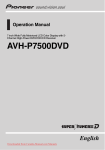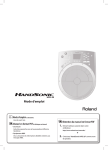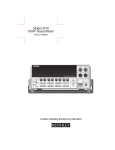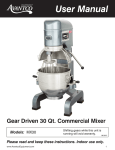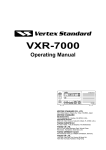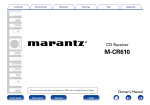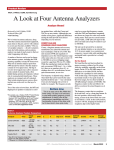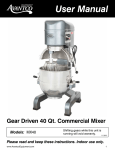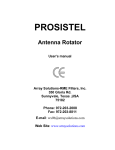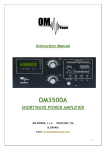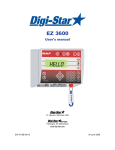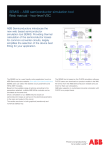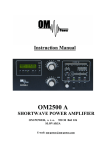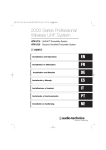Download User Manual External Radio Frequency Power Amplifier
Transcript
User Manual External Radio Frequency Power Amplifier Model OM2000+ FCC IDENTIFIER X8NX8NOM2000 Array Solutions 2611 North Beltline Rd Suite 109 Sunnyvale, Texas 75182 USA Tel: 214 954 7140 fax: 214 954 7142 E-mail: [email protected] Page 1 from 35 TABLE OF CONTENTS 1. GENERAL INFORMATION ..................................................................... 4 2.1. Introduction …………………………………………………………………. 4 2.2. Specification …………………………………………………………………. 4 2.2.1. Parameters …………………………………………………………………. 4 2.2.2. Protection Circuits …………………………………………………………………. 4 2.2.3. Indicators …………………………………………………………………. 5 2.2.4. Features …………………………………………………………………. 5 2. SAFETY INSTRUCTIONS …………………………………………………………………. 6 3. GENERAL DESCRIPTION …………………………………………………………………. 7 3.1. HF part …………………………………………………………………. 7 3.2. Power Supply …………………………………………………………………. 8 3.3. Safety Devices …………………………………………………………………. 9 …………………………………………………………………. 9 4. INSTALLATION 4.1. Grounding …………………………………………………………………. 10 4.2. Coaxial Cable …………………………………………………………………. 10 4.3. Control Cable …………………………………………………………………. 10 4.4. Main Supply …………………………………………………………………. 11 4.5. Cooling …………………………………………………………………. 11 …………………………………………………………………. 12 …………………………………………………………………. 12 5. OPERATION 5.1. Operation Elements 5.2. Preparation for operation ………………………………………………………………. 14 5.2.1. Display menu …………………………………………………………………. 15 5.2.2. Settings menu …………………………………………………………………. 17 5.2.3. Service menu …………………………………………………………………. 20 5.3. Operation mode …………………………………………………………………. 23 5.4. Tuning of the Power Amplifier ……………………………………………………… 24 6. MAINTENANCE 6.1. …………………………………………………………………. 28 Indication of Fault Conditions ……………………………………………………… 28 Page 2 from 35 6.2. Fuse Replacement …………………………………………………………………. 32 6.3. Tube Replacement …………………………………………………………………. 32 6.4. Cleaning …………………………………………………………………. 32 …………………………………………………………………. 33 7. APPENDIX 7.1. Primary AC selection …………………………………………………………………. 33 7.2. Removing the HV Transformer ……………………………………………………. 34 7.3. Block Diagram of the OM2000+ Power Amplifier ………………………… 36 Page 3 from 35 1. GENERAL INFORMATION 1.1. Introduction T he OM Power model OM2000+ is designed for all short wave amateur bands from 1.8 to 29.7 MHz (including WARC bands) plus 50 MHZ and all modes. It is equipped with a ceramic tetrode FU-728F. 1.2. Specification 1.2.1. Parameters Frequency Coverage Power Output Input Power Input Impedance Power Gain Output Impedance Maximum Output SWR SWR protection Intermodulation distortion Suppression of harmonics Tubes Cooler Power supply Transformers Dimensions Weight Amateur Bands 1.8 – 29.7 MHz including WARC + 50 MHz 1500 W in SSB/CW on HF bands, 1500 W in CW/SSB on 6m 1500 W in RTTY Usually 70 W for full Output Power 50 Ohm, VSWR < 1.5 : 1 15 dB 50 Ohm unbalanced 2:1 Automatic switching to STBY, when reflected power is 250W or higher 32dB below nominal output < -50 dBc FU-728F Ceramic tetrode Centrifugal blower + Axial fan Switchable 220V, 230V, 240V, 50/60 Hz One toroidal transformer 3kVA 390 x 195 x 370 (width x height x depth) 24 kg 1.2.2. Protection Circuits There are several protection circuits used in the amplifier. They are activated when one or more of next parameters exceed defined values or some unwanted occasion occurs. VSWR too high Anode current too high Anode voltage error Screen current too high Page 4 from 35 Screen voltage error Grid current too high Grid voltage error Heating voltage error Mistuning of PA Temperature to high Soft start for fuses protection “switch-on blocking “ at opened amplifier 1.2.3. Indicators Number of indicators visible on the front panel will inform you about value of some parameters or operation status: OLED display 4 x 20 characters Analog Wattmeter Double system meter for forward and reflected power measuring LED Indicators ON AIR STBY FAULT ON – amplifier in transmitting mode – standby mode – failure, switching off for abt. 4 sec – ON status 1.2.4. Features Manufacturer implemented some of the company’s current development results with most wanted operating and safety features into this new model: High level of protections Antenna switch for 3 different antennas Memory for faults and warnings, easy maintenance Automatic set-up anode current (BIAS) – no need to adjust manually after changing the tube Temperature controlled 2-speed centrifugal blower ( turbine ) + axial blower Full QSK with silent relay Many operational parameters to display Easy transport due to detachable HV transformer The smallest and lightest 1500 W PA on the market Page 5 from 35 2. SAFETY INSTRUCTIONS WARNING! DANGEROUS HIGH VOLTAGE INSIDE! The power amplifier is using high voltage up to 3000V DC, which is very dangerous for human life! Read next safety instructions carefully first, before you will start to install and operate power amplifier! NEVER VIOLATE NEXT RULES! WARNING! NEVER ALLOW CHILDREN to play around PA or to touch power amplifier or connected cables in working condition, or to push anything into the case holes! WARNING! Never turn the amplifier on without the upper lid in place. DO NOT ATTEMPT TO SHORT OR BYPASS safety switch under upper lid! WARNING! The OM2000+ amplifier is neither to be used in a WET or HUMID environment nor to be exposed to RAINFALL! WARNING! Do not turn the amplifier ON without having connected the ANTENNA or properly rated DUMMY LOAD! A hazardous HF voltage may build up on the antenna connector after turning the amplifier on with no antenna or dummy load connected! WARNING! Before opening the upper lid of the amplifier make sure that power supply has been disconnected AT LEAST 10 minutes allowing the electrolytic capacitors to discharge fully. Disconnect power cord from the outlet! WARNING! Any work inside the PA (internal fuses replacement, tube replacement, etc.) can be carried out only by professionally qualified person! Page 6 from 35 CAUTION The amplifier must be installed in such a way that free flow of hot air from the tube is allowed. The amplifier must not be installed in a constrained surrounding (i.e. tight shelves etc.). During long time operation ventilation grid can reach high temperature. Do not touch it! CAUTION The amplifier must be properly grounded during operation . CAUTION During operation the amplifier must be installed in such a way that the rear side remains accessible. CAUTION The amplifier is an A category product. In a household it can influence other electric appliances. In such cases the user is to take proper actions to mitigate this disturbance. CAUTION Read this manual carefully. Fallow all of instructions during installation and operation to avoid damage to the amplifier not covered by manufacturer´s warranty! Do not attempt to perform any change of hardware or software! 3. 3.1. GENERAL DESCRIPTION HF part T his amplifier is using a ceramic tetrode FU-728F in a grounded-cathode circuit (input into control grids). The OM2000+ amplifier achieves excellent linearity by the voltage stabilization of the control grid bias and the screen voltage. The power input is given to the control grids, using a broadband input circuit with an input impedance of 50 Ohms. This adaptable input circuitry ensures a good input SWR (better than 1.5 : 1) on all amateur bands. Page 7 from 35 The output of the amplifier is a Pi-L circuit. The ceramic capacitor for TUNE and LOAD are divided. This enables the amplifier to be tuned exactly and makes it possible to easily return to the previously set positions after band changes. Top view on the opened OM2000+ Tetrode FU728F Antenna Switch Output Pi-L Circuit 3.2. Blower Tuning Capacitor Power Supply Board Subpanel Switch-ON Board HV transformer Power Supply Power amplifier is using one 3 KVA toroidal transformer. A soft start is provided using relays and resistors (placed on the switch-ON board). The high voltage is made by combining 4 x 530V AC (total abt. 2950V DC) @ 1.2A. Each has its own rectifier and filter. In the high voltage circuit, safety resistors are employed to protect the amplifier against overload (placed on the power supply board). The separated supply for screen grid is regulated by stabilization with MOSFET and delivers abt. 330V DC at 100mA. Control grid voltage is also stabilized (-120V DC). Change of stabilized first grid voltage is controlled by the software (EBS for example). Page 8 from 35 Type of supported TCVR and working 3 kVA toroidal transformer is visible on the left frequency are visible on the display. side. Switch-ON board is in the front, Power supply board behind it. AUTO LED is ON. CAUTION Primary section of the transformer is switchable for 220 - 240 VAC. Factory setting is 230VAC. If the AC voltage in your network is 220 or 240 Volts, you need to set the correct value before first starting of the PA. See part 7.1. for more information. 3.3. Safety Devices Control and monitoring circuits ensure control and safety during malfunctions of the PA. These are placed on the Control board, which is located on the chassis subpanel. One of the important safety element is mechanical switch for AC blocking at working opened Type of supported TCVR and amplifier. frequency are visible on the display. AUTO LED is ON. 4. INSTALLATION NOTE Read this chapter carefully prior you will start installation. Before unpacking inspect shipping carton first, if it is not damaged. Keep all of packing parts for possible future shipment. Check unpacked power amplifier. If you find some damaging, contact your dealer immediately to keep full warranty. During installation go step by step according to the next parts. Page 9 from 35 4.1. Grounding CAUTION The amplifier has to be grounded properly! Connect the screw on the rear panel of the amplifier to your local grounding system with a copper cable; use a cross-section of 4 mm2 at least. Connect your transceiver to the same grounding system of your shack carefully! Use minimum length cables and make certain that the connections are both physically and electrically sound. With poor grounding, you may risk damaging your equipment, having problems with TVI/BCI or your transmitted signal may be distorted. 4.2. Coaxial Cable The output of the transceiver is to be connected to the input of the amplifier via RG58 or similar cable. For the connection between the power amplifier and the antenna, RG213 or similar coaxial cable suited for high power is recommended. All the INPUT and three OUTPUT (ANT1, ANT2, ANT3) SO-239 sockets with Teflon insulation are used. Rear view of the amplifier OM2000+ Fuses Mains Plug Auxiliary fan 4.3. Grounding point HF Outputs Control HF Input Control Cable Control cable maintains TX / RX switching of the PA (TX GND). The cable is shielded. On the side of the power amplifier a CINCH-socket is used. On the side of your transceiver you have to use a socket suitable for this transceiver. During transmitting the middle pin is connected to the ground. The relays of the OM2000+ have to be switched earlier than HF is applied (cold switching). Modern transceivers they have a time delay between PTT switching and power output. Page 10 from 35 CAUTION If you are using an older transceiver or transmitters without time delay, we recommend to connect the PA in such a way that the transmit/receive switch (foot switch for example) is connected with the KEY IN socket of the amplifier. The KEY OUT socket is to be connected with the PTT socket at the transceiver. The amplifier is equipped with safety devices, which ensure that the output relay is not switched under power mistakenly (hot switching). KEY IN KEY OUT 4.4. RCA Phono - Input signal PTT switching voltage / current - 5V /2mA) RCA Phono - Output signal PTT (maximum switching of 30V / 50mA) Main Supply CAUTION Be sure you got PA with properly terminated line cable, corresponding with your power system’s outlet. If not, contact your dealer. In such a case you should make the necessary changes using a licensed electrician. WARNING! Be sure that your power system is correctly wired and properly rated! To use adequately sized and connected grounding system is also very important. 4.5. Cooling CAUTION The amplifier must be installed in such a way that free flow of hot air from the tube is allowed. Do not obstruct air intake and exhaust areas of the PA. The centrifugal blower provides basic cooling of the amplifier. Blower is activated by switching the PA on and it is turned off when cooling is finished (approx. 1-5 min after switching off the PA depending on the temperature of the tube). Blower speed (2 steps) is setting automatically according to the tube temperature. For long time operation (contests) the PA is equipped with an auxiliary fan, which can operate in three modes (go to Settings menu for more details). Detailed view on the tube and blower area. Antenna switch (above) isTCVR installed inside the Type of supported and working metal box. frequency are visible on the display. AUTO LED is ON. Page 11 from 35 5. OPERATION WARNING! Before switching PA on, make sure that amplifier is grounded, antenna or dummy load is connected, and line cord is putted to the outlet. Be sure you selected AC input by 7.1. CAUTION Before switching PA on, check all connections between PA and TCVR. CAUTION Do not turn PA on for at least 2 hours after unpacking it and locating in its operating location. Especially when amplifier is moved from a cold place to a warm one because not visible condensation may develop, and this could result in damage to the high voltage circuits of the PA. CAUTION Never try to change antenna output during a transmission to avoid warranty loss. NOTE When you decide to have a short operating break, place the amplifier to the standby mode rather than switch it off. 5.1. Operation elements There is couple of operational elements accessible or visible on the front panel. Page 12 from 35 BAND - Band selector switch TUNE - Anode capacitor for tuning (higher frequencies to "0"; lower frequencies to „100“). LOAD - Output capacitor tunes antenna load resistance to the amplifier. Capacity is low at „100“ and high at "0" on the scale. WATMETER - Analog double system meter for forward and reflected power measuring ON / OFF - Long press (abt. 1 sec.) to switch PA ON/OFF RESET - Short press to reset faults or warnings 0/I S1 S2 Power ON small 12V APU for logic and protection circuits You can switch Antenna ports even if PA is switched OFF. S3 S4 Page 13 from 35 ON AIR - Transmitting mode LED STBY - Standby mode LED FAULT - Failure LED ON - PA is „ON“ LED S1 - OPER / STBY - Press to switch between Standby and Operation mode ESC - Return to the previous level S2 - MENU DOWN - Enter the Menu - Scroll down S3 - DSP UP - Change display (DSP1, DSP2, DSP3) - Scroll up S4 - ANT ENT - Change Antenna output (ANT1, ANT2, ANT3) - Confirm the selection More functions of S1-S4 buttons will be described in next parts of this manual. 5.2. Preparation for use The first necessary thing after connecting AC to the power amplifier is switching main (green) switch to „ I “. Welcome message and then starting information appears on the display: After switching main switch ON welcome of supported messageType appears shortly. TCVR and working frequency are visible on the display. AUTO LED is ON. Starting message shows which antenna is Type supported TCVR and ON-OFF working connected. Toofswitch PA ON press button forfrequency abt. 1 second. are visible on the display. AUTO LED isItON. Warming time takes abt. 210 seconds. is possible to enter MENU during this time, but with limited possibilities (display settings can Typefor of example). supported TCVR and working be changed, You can change ANTare output, necessary. frequency visibleif on the display. Page 14 from 35 AUTO LED is ON. If you change DSP during warming time, you lost count down information. Press BACK (S1) to restore starting message. When warming time expires, PA switches Type of supported TCVR and working itself automatically to the STBY mode. frequency are visible on the display. You have two possibilities now - switch PA to OPER mode and start operation, go AUTO OR LED to is ON. thru MENU and submenus to set display parameters, some hardware parameters or to enter the service menu. In the STBY or OPER mode Antenna output can be changed (ANT1, ANT2, ANT3) by pressing S4. This feature is active also if PA is switched OFF. However, the main switch (green) must be ON in order to switch the antenna. Display information can be changed, too. Press S3 Type to doof it.supported TCVR and working frequency are visible on the display. AUTO LED is ON. There are 3 different display settings possible in the OM2000+. To set display parameters, supported TCVR and go to theType nextofpart of this manual forworking more details. frequency are visible on the display. AUTO LED is ON. 5.2.1. Display menu The OLED display shows couple of parameters or texts. Display has 4 lines. Three of them are editable. In every line user can select different parameters, using MENU. See next pictures. Page 15 from 35 After pressing MENU (S2) S1–S4 buttons changed their functions. To edit display Type of supported TCVR and working parameters, press DISP button. frequency are visible on the display. AUTO LED is ON. Press DIS1 to edit first display. Type of supported TCVR and working frequency are visible on the display. AUTO LED is ON. Now you can define parameters for first three rows. Start with first line, press 1Row button. Type of supported TCVR and working frequency are visible on the display. AUTO LED is ON. Go UP or DOWN to select desired parameter. Press ENTType to confirm selection. of supported TCVR and working frequency are visible on the display. There are 4 possible settings for the first line (one bar-graph or three pairs of different parameters): AUTO LED is ON. Forward bar-graph Forward Power _ Reflected Power Forward Power _ SWR Plate voltage Up _ Plate current Ip Second and third line are divided to the left and the right side, editable independently. To each of these positions one of the 15 different parameters should be set. If you finish first line settings, press ESC to go back to the row selection. Type of supported TCVR and working To start edit second line, press 2Row button. frequency are visible on the display. AUTO is 35 ON. Page 16 LED from S2 and S3 now changed their functions. To edit left sideofofsupported the second line,and press LEFT Type TCVR working button. frequency are visible on the display. AUTO LED is ON. Go UP or DOWN to select desired parameter. Press ENT to confirm selection. Type of supported TCVR and working frequency are visible on the display. AUTO LED is ON. If you finish left side settings, press ESC to go back to the side selection. Type of supported TCVR and working To start edit right side, press RIGHT frequency are visible on the display. button….etc. Second and third line programmable parameters are: 5.2.2. AUTO LED is ON. Forward Power Reflected Power Input Power SWR TUNE Temperature Frequency Plate voltage – Up Plate current – Ip Screen voltage – Us Screen current – Is Screen current – graph Grid voltage – Ug Grid current Ig Heating voltage – Uf Settings menu Settings menu offers EBS settings, factory default parameters restoring and display contrast settings (software version 6.1. or higher). Page 17 from 35 Electronic Bias Settings (EBS) is one of significant feature of the power amplifier. It allows to set low plate current after pressing the PTT regardless of whether you have CW or SSB mode, until RF signal is no present at the input. At the moment when RF signal comes to the input of PA, bias will automatically change to its working value. EBS level means level of the Input power, where EBS starts working. Default EBS value is 0.2 W. We recommend using EBS ON. Significant accompaniment of used EBS is temperature reducing. To enter Settings menu, go to MENU first, then press SET button. Type of supported TCVR and working frequency are visible on the display. AUTO LED is ON. Use UP or DOWN button to select EBS ON/OFF. Press ENT to enter EBS status settings. Type of supported TCVR and working frequency are visible on the display. AUTO LED is ON. Press ON or OFF to set status of EBS. Press ENT to confirm selection. Type of supported TCVR and working Press ESC to go one level back. frequency are visible on the display. AUTO LED is ON. Use UP or DOWN button to select EBS level parameter. Press ENT to enter EBS level settings. Type of supported TCVR and working frequency are visible on the display. AUTO LED is ON. Use UP or DOWN button to set EBS level value. Press ENT to confirm EBS level value. Type of supported TCVR and working Press ESC to go one level back. frequency are visible on the display. AUTO LED is ON. Page 18 from 35 If you wish to restore factory default parameters, use UP or DOWN button to Type default of supported TCVR and working select Restore parameters. Then press ENT. frequency are visible on the display. AUTO LED is ON. Press YESType for 1of second to confirm restoring. supported TCVR and working frequency are visible on the display. AUTO LED is ON. Use UP or DOWN button to select LCD contrast. Press ENT. Type of supported TCVR and working frequency are visible on the display. AUTO LED is ON. Use UP or DOWN button to set contrast value. Press ENT to confirm settings. Type of supported TCVR and working frequency are visible on the display. AUTO LED is ON. Use UP or DOWN button to set auxiliary fan working condition. Type of supported TCVR and working Press ENT to confirm settings. frequency are visible on the display. AUTO LED is ON. Use UP or DOWN button to set first mode. The fan will activate at a fixed temperature (programmed Type in of uP). supported TCVR and working Press ENTfrequency to confirmare settings. visible on the display. AUTO LED is ON. Page 19 from 35 Use UP or DOWN button to set second mode. The fan will activate together with PTT. Type of supported TCVR and working Press ENT to confirm settings. frequency are visible on the display. LED is ON. Use UP or DOWN button toAUTO set the third mode. The fan will turn always when PA will Type ENT of supported TCVR and working be ON. Press to confirm settings. Press ESC twice to release Settings mode. frequency are visible on the display. 5.2.3. Service menu AUTO LED is ON. In the Service menu it is possible to verify software version. This menu allows user to check total operating hours and listing in the memory, where reported faults and warning messages are stored. You can display particularly warning messages and particularly error messages. See chapter 6 for more information regarding to warnings and faults occurrence. There you can find a coding table together with a limited values for the safety circuits activation also. In the Service menu a value of EBS1 and EBS2 can be automatically adjusted. This is used for example when it is necessary to make adjustment after replacing the tube. Automatic control of EBS, however, can be done at any time. EBS1 default value is 20mA of Ip, EBS2 default value is 250mA of Ip. Use Service menu after replacing the tube. This is step No. 1. Type of supported TCVR and working To enter Service menu, go to the MENU first, are visible on the display. then pressfrequency SERV button. AUTO LED is ON. Use UP or DOWN button to check software version. Type of supported TCVR and working frequency are visible on the display. AUTO LED is ON. Page 20 from 35 Use UP or DOWN button to select Time ON parameter. Press ENT to see total operating TypePA. of supported TCVR and working hours of the frequency are visible on the display. AUTO LED is ON. Press ESCType to goofback to the Service menu. supported TCVR and working frequency are visible on the display. AUTO LED is ON. Use UP or DOWN button to select Faults. Press ENT to see fault numbers or letters (see of supported TCVR and working the table Type in chapter 6). frequency are visible on the display. AUTO LED is ON. Press ESCType to goofback to the Service menu. supported TCVR and working frequency are visible on the display. AUTO LED is ON. Use UP or DOWN button to select Warnings. Press ENT to see warning numbers or letters Type in of chapter supported (see the table 6). TCVR and working frequency are visible on the display. AUTO LED is ON. Press ESC to go back to the Service menu. Type of supported TCVR and working frequency are visible on the display. AUTO LED is ON. Page 21 from 35 Use this procedure after replacing the tube. This is step No. 2. of supported TCVR andsettings. working Scroll UPType or DOWN to select EBS1 Press ENT to start automatic adjustment of frequency are visible on the display. EBS1 (20 mA). AUTO LED is ON. Automatically increasing of the grid voltage (decrease of the negative value) causes a Type of supported TCVR and working gradual increase in the plate current. In the moment, when Ip reaches 20mA, adjustment frequency visible on the display. stops. Press ESC afterare stopping. AUTO LED is ON. Use this procedure after replacing the tube. This is step No. 3. Scroll UPType or DOWN to select EBS2 of supported TCVR andsettings. working Press ENT to start automatic adjustment of are visible on the display. EBS2 (250 frequency mA). AUTO LED is ON. Automatically increasing of the grid voltage (decrease of the negative value) causes a gradual increase in the plate current. In the TCVR and working moment,Type whenofIpsupported reaches 250mA, adjustment stops. Press ESC afterare stopping. frequency visible on the display. AUTO LED is ON. Use UP or DOWN to select Calibration Ip & Is. Press ENTType to doofit.supported TCVR and working frequency are visible on the display. AUTO LED is ON. Ip and Is calibration runs in the background. Type of supported TCVR and working Result only is visible on the display. are visible Press ESC frequency to go one level back. on the display. Page 22LED from 35 AUTO is ON. 5.3. Operation mode CAUTION In STBY the amplifier is in bypass-mode and your transceiver is directly connected to the antenna. Maximum allowed power in bypass mode is 100 Watts! Passing RF power is measured with analog wattmeter only. It is not displayed if PA is either in standby mode or turned OFF. Press OPER to activate operation mode. STBY LED switched OFF. Changing of DSP allows user to watch couple of basic parameters of the PA in operation mode without input RF signal. Notice: These Type of supported TCVR and working are three default display settings (software version 6.1.) frequency are visible on the display. AUTO LED is ON. Check all connections again. Set BAND selector, TUNE and LOAD capacitors according to TCVR parameters and delivered tuning table (see next part for more details). Apply low input power and press PTT. Check Analog wattmeter first. Try to tune PA for maximum output power and minimum SWR. Page 23 from 35 Using foot switch in „KEY IN” we Type of supported TCVR and working activated transmitting mode of the PA first. frequency are visible on the display. “ON AIR” LED is ON. EBS is active (Ip = 20mA)AUTO LED is ON. In the transmitting mode all 4 buttons (S1, S2, S3, and S4) are blocked! Type of supported TCVR and working frequency are visible on the display. An example of standard tuning procedure using Analog wattmeter. AUTO LED is ON. 5.4. Tuning of the Power Amplifier The OM2000+ power amplifier is operated in class AB. Thus it’s possible to obtain a maximum output power at excellent linearity. For this purpose the amplifier has to be tuned carefully . CAUTION The operation of a mistuned PA will cause malfunctions, the increase of grid current and problems with TVI/BCI. CAUTION If the input power is higher than 10W and the power amplifier is NOT correctly tuned, the safety devices will switch it to STBY. After switching the amplifier to STBY, you need to switch it back to the OPER mode by pressing RESET button shortly. Page 24 from 35 A tuning table is delivered with the power amplifier. For coarse tuning select a band with BAND switch and choose the setting of “TUNE” and “LOAD” capacitors according to the table. Band (MHz) Tune Load Input PWR (W) Output PWR (W) 1.845 70 45 75 1500 3.630 69 51 72 1500 7.050 50 90 71 1500 10.125 72 28 72 1500 14.175 69 40 70 1500 18.150 81 48 69 1500 21.230 47 67 65 1500 24.940 61 64 59 1500 28.450 33 76 52 1500 50.200 22 90 64 1500 NOTE Delivered tuning table was made for 50 Ohm loading of PA (dummy load). Each amplifier should have different values depending on used frequency and used type of antenna. Make your own table valid for your real conditions. There are two ways how to do fine tuning. The first method uses a gradual increase in the input power when tuning the PA (as most operators accustomed). In every case we recommend adjust the display for both of methods so it shows two parameters important for fine tuning - TUNE and Is graph (> l <). Press OPER to enter operation mode. Apply low input power and press PTT. Be sure you selected right BAND, TUNE and LOAD knob positions. If you made some mistake, fault message appears: Safety circuit stopped transmitting, fault LED Type of supported TCVR working is ON (Fault code 4 is saving to theand memory). frequency are visible on the display. Release PTT, set proper positions of BAND, TUNE and LOAD according to the table and press PTT again. AUTO LED is ON. Page 25 from 35 Another mistake can occur, if you have antenna connected to the wrong output. In such a case „SWR is too high“ error message appears. Change antenna output using S4 button. This is not an optimal result, TUNE indicator must go between both arrows. Use TUNE knob to get maximum output power and Type of supported TCVR and working LOAD knob to get indicator between arrows. frequency are visible on the display. AUTO LED is ON. Another example of not optimal result, TUNE indicator must go between both arrows. Use TUNE knob to get maximum output power Type of supported TCVR and working and LOAD knob to get indicator between arrows (in frequency arrows direction). are visible on the display. AUTO LED is ON. This is a good result of tuning. Type of supported TCVR and working frequency are visible on the display. Now increase the input power slowly and watch the display. AUTO LED is ON. Two of important information is visible – screen current increased, but still is within the allowed limits. Turn LOAD knob slightly Type of supported TCVR and working in arrows direction to get TUNE indicator between arrows. frequency are visible on the display. AUTO LED is ON. Display indicates correct tuning of the Power amplifier.Type of supported TCVR and working frequency are visible on the display. AUTO LED is ON. Page 26 from 35 Remember Always use TUNE knob to get maximum output power. Use LOAD knob to get TUNE indicator on the display to the middle position between both arrows. Simultaneously check if Is graph indicator stays within the boundaries. Repeat both steps more times. Proper operation mode of FU-728F requires the plate voltage to be close to 3 kV. If anode voltage without RF power is much lower, watch the heating voltage, too. Normally, heating voltage must be in boundaries from 8.5 to 9 V without RF signal (DSP3). Heating voltage level is a reliable indicator of correct AC selector adjustment. If you see heating voltage lower than 8.5V without RF signal, change primary AC voltage selector one step down (if possible). Conversely, if the voltage is higher than 9V, try to move AC selector one step up (for example from 220 to 230 VAC). Check heating voltage under full load (full output power), also. If the heating voltage without RF signal is OK but under full load drops more than 1.5 V, this relates to the „soft“ AC network and is solvable only by „changing“ the AC network... Without RF power the plate voltage is OK. Type of supported TCVR and working frequency are visible on the display. AUTO LED is ON. Without RF power the plate voltage is 2.85 kV. Check the heating voltage, too. If it is below 8.5 V, this indicates the need to change AC Type of supported TCVR and working selector position one step down (for example from 230 to frequency 220 VAC). are visible on the display. To start the second method of fine tuning, press S2 (TUNE) button in OPER mode. AUTO LED is ON. PA is in the operation mode. After TUNE button (S2) was pressed, it changes its function. Now STOP is blinking. Type of supported TCVR and working Do not press STOP button yet! frequency are visible on the display. Apply input power according tune table (or lower) for selected band and press PTT. Use TUNE knob to AUTO LED is ON. get maximum output power. Use LOAD knob to get Is graph indicator within the boundaries. Page 27 from 35 Display shows properly tuned PA. TUNE indicator is in the middle, Screen current is higher, but still inside the limits. After proper fine tuning release PTT and press STOP button. PA isType now of prepared for TCVR operation. supported and working frequency are visible on the display. AUTO LED is ON. View on the properly tuned PA. Analog Type of supported TCVR andreflected working wattmeter shows forwarded and power. frequency are visible on the display. AUTO LED is ON. After this procedure the amplifier is tuned correctly and ready to give 1500 W output power in all operation modes. At optimal tuning and full output power a positive max. 50mA current goes through the second grid. CAUTION If the amplifier demonstrate any malfunctions during tuning or it does not behave in accordance witch the description, interrupt the tuning procedure immediately and check the amplifier! Be sure not to do any mistakes in choosing bands or TUNE/LOAD values! Be sure that VSWR is not higher than 2:1 and input power is LOW! After excluding possible human mistakes you will be able to work for long time with this amplifier! 6. 6.1. MAINTENANCE Indication of Fault Conditions If a fault condition appears during the operation of the amplifier, the safety circuits of OM2000+ will react. There are several warning or fault messages possible to appear on the display, when some of the protection will be activated. The OM2000+ power amplifier can report one of the following messages: Page 28 from 35 1 2 3 4 5 6 7 8 9 A B C D E F - Power Out is too high Refl. power too high Power In is too high Low output power (tune) Plate current too high Grid current is high Screen current error N/A Heating voltage error HARD FAULT Plate voltage error Grid voltage is low Screen voltage error SWR is too high Amplifier is too hot NOTE Most of safety circuits are preset for two levels of exceedances. First level is a warning level. In such a case a warning message appears on the display, fault LED will flash, but power amplifier will stay in normal operation. See the table below for warning and fault conditions. NOTE When a fault condition appears during the tuning or operation of the amplifier, the safety circuits will block transmitting and FAULT LED starts blinking. The amplifier stays in OPER mode. After approx. 1 sec the control circuits will automatically switch the amplifier back to the transmitting mode. If problem persists, safety circuit will react again. CAUTION If the fault will repeat 3 times during 10 seconds, the safety circuits will turn the amplifier to STBY mode. FAULT LED stays ON. To cancel fault status, press RESET shortly. Power amplifier will stay in STBY mode. All the warning and fault messages are stored in the memory. You can display particularly warning messages and particularly error messages. See the Service menu in the 5.2.3., how to select service display. All of messages are stored and displayed as a numbers or letters as indicated in this chapter (1 - 9; A - F). They are stored one by one to the memory. You can see them on the display in three lines, on every second display position (maximum 10 per row, maximum 30 messages for warnings and 30 messages for errors). If memory is full, every new message will delete oldest one and move rest of them one position back. It means that every time last 30 messages are visible on the display. Next table shows limited values for the safety circuits activation. Fault code 1 Parameter Power Output is too high 2 3 4 Reflected power is too high Power Input is too high Low output power (tune) Warning level 2200W 1700W (50MHz) 250W 100 W Fault level 2300W 1800 (50MHz) 300W 120W > 3dB below* Page 29 from 35 5 6 7 8 9 A Plate current is too high Grid current is too high Screen current is too high N/A Heating voltage error HARD FAULT (from 3.1 version) 1.8A 10mA 50mA B Plate voltage error C D Grid voltage is low Screen voltage error Min. 1800V Max. 3400V -40V Min. 250V Max. 400V E F SWR is too high Amplifier is too hot +/- 2V *** 80 deg. C ***** 2.0A 20mA 60mA N/A +/- 2.5V Plate current >2.5A **** Min. 1500V Max. 3500V -30V Min. 220V Max. 420V 3:1 90 deg. C ***** 1. * This fault indicates mistuning of the PA. It works for Input power higher than 10W. If output power decreases more than 3dB below value corresponding with the applied Input power, fault message „Low output power“ appears. You have to tune the PA correctly. 2. *** When the heating voltage exceeds boundaries 9V +/- 2V, warning message „Heating voltage error“ appears. Check proper position of AC selector (page 25). Heating voltage without RF signal should be between 8.5 and 9V. 3. **** „HARD FAULT” appears if the plate current exceeds 2.5 A. In such a situation hardware will immediately disconnect high voltage from the plate. Fault is signed with the letter „A“ in the memory. If error occurs frequently, consult this situation with the manufacturer, please. 4. ***** If temperature sensor inside the PA detects of 80 deg. Celsius, warning message „Amplifier is too hot“ appears on the display. At 90 degrees protection circuit will automatically block transmitting (fault condition). You have to decrease the power or wait couple of minutes to be ready transmitting again. Fault is signed with the letter „F“ in the memory. An example shows situation when Input power is too high. By pressing PTT safety circuit will react quickly, error message appears and FAULT LED starts blinking. In this case screen current exceeds limited value (60mA). Type of supported TCVR and working After abt. 1 sec. PA returns to TX mode. frequency are visible on the display. Reduce Input power to avoid fault repeating. AUTO LED is ON. Page 30 from 35 This is the situation, when problem with high Input power persists. Safety circuits reacted 3 times, and then switched PA to STBY mode. Permanent fault appears. Type of supported TCVR and working To return PA to the normal operation, decrease Input power then fault frequency arefirst, visible onreset the display. status and go back to the OPER mode. AUTO LED is ON. If resistor R1 or fuse F3 is damaged, safety circuit stops starting of the PA and fault message appears on the display. It is necessary to replace the damaged component. Type of supported TCVR and working frequency are visible on the display. AUTO LED is ON. Fuse F3 Resistor R1 Type of supported TCVR and working frequency are visible on the display. If there is a fault condition, always try to remove the cause first. If it is not a hardware failure, it usually succeeds. For example high VSWR, high Input power, mistune of PA, high temperature, AUTO etc. LED is ON. In the case of some hardware failure or if your power amplifier is not working properly, please contact the manufacturer or your dealer. WARNING! Never try to change or move any part inside the amplifier except of tube or fuses. Substitution of parts may void intrinsic safety! Manufacturer’s contacts: OM POWER, s.r.o. 930 30 Báč 126 SLOVAKIA Email: [email protected] Page 31 from 35 Dealer in USA: Array Solutions 2611 North Belt Line Road Suite # 109 Sunnyvale, TX 75182 Tel: (214)954-7140 Email: [email protected] 6.2. Fuse Replacement The user is allowed to change mains fuses (6.3 x 32mm), accessible from the rear panel, only. In the case of fuse (fuses) interruption inside the power amplifier, exchange can be carried out only by professionally qualified person! Internal fuses are located mainly on the SWITCH-on board (next to the HV transformer). One special fuse is used in the model OM2000+. In the case of an accidental discharges in the tube this fuse saves HV supply circuits. Type of supported TCVR and working frequency are visible on the display. Fuse AUTO LED is ON. 6.3. Tube Replacement In the case of vacuum tube damaging, contact the manufacturer or your dealer for ordering new one. You will get instructuions how to change it. Exchange can be carried out only by professionally qualified person! After tube replacing automatic BIAS adjustment must be done. Read Service menu (5.2.3.) and pictures on page No. 20 for more details. 6.4. Cleaning To prevent damage to amplifier surface and plastic components do not use aggressive chemicals for cleaning. Do not open the amplifier for cleaning. Outer surface may be safely accomplished by using piece of soft cotton cloth moistured with clean water or window cleaner. Page 32 from 35 7. 7.1. APPENDIX Primary AC voltage selection Primary section of the HV transformer is switchable for three values of AC voltage (220, 230, 240V). Factory settings is 230VAC. Before first starting of the PA we recommend to check the correct value according to the AC voltage in your network. Change the settings, if necessary. Side view on the opened OM2000+ HV Transformer AC Selector Page 33 from 35 Remove the upper lid first. On the right side of the PA, next to the HV transformer there are two PCBs mounted. On the left upper side of the front (Switch-ON) board connector J6 is located. Use flat screwdriver or finger and press carefully the white stick to release contact and move upper end of the white jumper to the proper position, if necessary. Jumper must be connected between bottom contact and of remaining contacts. AC Typeone of supported TCVR and working voltage is marked next to every contact. frequency are visible on the display. AUTO LED is ON. NOTE AC selector range can be changed in the production according to the specific conditions in individual countries. 7.2. Removing the HV Transformer For simpler and easier transport of the PA, HV transformer can be removed and taken separately. This distributes the weight of the PA (24 kg) about half and half. Follow next steps to do it. 1. 2. 3. 4. Remove upper lid from the PA. Turn the PA on the left side (transformer is up). Disconnect 3 connectors from the front board and 1 connector from the rear board. Release 4 screws from the bottom side of the PA. Use Philips screwdriver P2. During the release of the last 2 screws hold the transformer by hand. Do not worry about its weight, it will move down just 1 cm and remains on the central rung of the PA. 5. Use both hands to take transformer away from the chassis. Watch the released terminals, when moving the transformer! Do not damage transformer insulation during removing and transportation. Type of supported TCVR and working frequency are visible on the display. AUTO LED is ON. Page 34 from 35 Weight of the PA was distributed (transformer has 12 kg, rest of the PA has cca 12 kg, too). Type of supported TCVR and working frequency are visible on the display. AUTO LED is ON. When refitting the transformer, watch to the correct location of individual sections and wires. NOTE Manufacturer reserves the right to make future changes in the way of connecting the transformer to the board. Allways mark the position of the terminals before disconnecting the transformer. Page 35 from 35 7.3. Block Diagram of OM2000+ Power Amplifier Page 36 from 35




































